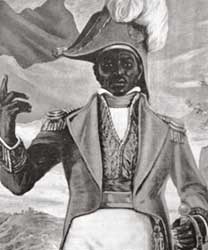African culture, resistance live in Haiti
Published Feb 3, 2010 5:05 PM
The following is based on a talk given by G. Dunkel at a NYC Workers
World forum on Jan. 29.
It is useful in understanding the current situation in Haiti to examine
its roots — in particular why Haiti should be regarded as a country with
an African culture and how U.S. and other imperialist interventions in Haiti
met a stubborn and tenacious resistance.
African culture
Its successful and singular revolution, expelling French colonialism and ending
slavery in 1804, meant Haiti kept its own institutions, which were and are
African. Haiti also kept its own language, which is Creole, a melding of
African structure and French vocabulary. Over half of Dessalines’
anti-slavery army had been born in Africa, and they needed a common language
for their struggle.
One striking feature of the life of Haitian peasants is the institution of the
konbit, a large group of peasants working collectively to complete a major
project. Konbits, or coumbites, are a feature of Western African society.
Whether or not they approved of Voodoo, an African religion, or the
civilization currently existing in Africa, Haitian intellectuals beginning in
the 1820s had to recognize that Haiti was profoundly influenced by its roots in
Africa.
You can see how much Haiti’s revolution threatened the U.S. slaveocracy
with this fact: The first foreign aid the U.S. ever granted was $700,000 to the
slave owners in Haiti to put down the revolutionary uprising.
After 1804 Haiti had a peasantry with some access to weapons. These peasants
were confronting big landlords, called grandons, and the merchants and traders,
a nascent bourgeoisie, in the cities. The Haitian army, which had a
revolutionary tradition, always wavered from side to side. One way to see the
next 100 years is as a class struggle conducted with arms.
Foreigners were constitutionally forbidden to own land. The fear of
reenslavement kept Haitians from traveling and establishing foreign
trade.
Imperialist interventions and Haitian resistance
In return for recognition of Haiti’s independence, France demanded and
got 150 million gold francs in 1825 to pay for the “loss of
property” suffered by the French slave owners. Haiti had to pay for the
freedom it won with its blood.
This extortion was a major burden on Haiti’s economy. Haiti had to borrow
the money to pay France from private French, British and American banks, and
didn’t finish paying all these loans off until 1947.
All four U.S. invasions — 1915-34, 1994, 2004 and 2010 — were
justified with so-called humanitarian reasons and allegedly designed to promote
“stability,” which is another name for U.S. interests.
The first U.S. invasion in 1915 disarmed the peasants and set up a new Haitian
army to control and repress the population. Henceforth coups were to be
organized by the army. Charlemagne Péralte and Benoit Betraville are two
heroes who died leading the resistance to this invasion.
During the Great Depression, U.S. military occupation of Haiti grew expensive
and Haitian resistance was growing. So the U.S. troops left Haiti in 1934. That
was the same year the Haitian Communist Party was founded.
After a lot of coups and finagling — which Haitians call magouillage
— and the growth of populist movements, the Duvaliers (first father, then
son) ruled from 1957 to 1986. A dechoukaj — uprooting — began when
the people grew hungry in the provinces. Jean-Claude Duvalier with his
household goods and hundreds of millions of dollars in foreign banks was flown
out to the French Riviera on a U.S. jet.
It was under the Duvaliers that Haiti’s markets were opened up to foreign
competition. This influx of foreign goods has basically destroyed Haiti’s
subsistence agriculture.
After one election was drowned in blood, pressure grew for a free and fair one.
Jean-Bertrand Aristide ran in 1990 and won with 67.5 percent of the vote
against Marc Bazin, the U.S.-backed candidate, who had less than 15
percent.
After eight months as president, Aristide was overthrown. Four thousand people
died in the streets demanding his return in demonstration after
demonstration.
Aristide returned three years later along with another U.S. military
occupation. At that time, he managed to declare the Haitian army disbanded
before stepping down from the presidency.
He ran again in 2000, and this time got 92 percent of the vote. Since there was
no standing army in Haiti under U.S. control, it took three years to overthrow
him. U.S. Special Forces bundled Aristide onto a U.S. Air Force jet and flew
him to the Central African Republic.
After he was gone from Haiti, there was a joint U.S., Canadian and French
invasion, followed by a United Nations occupation.
Over the past six years, thousands of Haitians have marched to demand
Aristide’s return, even at the risk of their lives. His political party
Fanmi Lavalas is still the majority party in Haiti. The only reason it
doesn’t win in elections is that the government keeps it off the
ballot.
Following the earthquake, Aristide offered to return to help his people through
this catastrophe, Haiti’s Hurricane Katrina. But the 13,000 U.S. troops
who have effective control of Haiti will undoubtedly use force to keep him out,
as the U.S. has shown it will tolerate no really popular government there.
If Haiti’s resistance to the occupation succeeds, U.S. imperialism will
have greater problems maintaining its influence in the Caribbean and South
America.
Articles copyright 1995-2012 Workers World.
Verbatim copying and distribution of this entire article is permitted in any medium without royalty provided this notice is preserved.
Workers World, 55 W. 17 St., NY, NY 10011
Email:
[email protected]
Subscribe
[email protected]
Support independent news
DONATE


